A timing belt is a toothed belt made of reinforced rubber that rides on sprocket wheels. Timing belts are used in many automotive and industrial applications to keep engines and machinery running smoothly. They are often used in conjunction with timing chains or gears. Timing belts are typically located inside an engine’s timing cover.
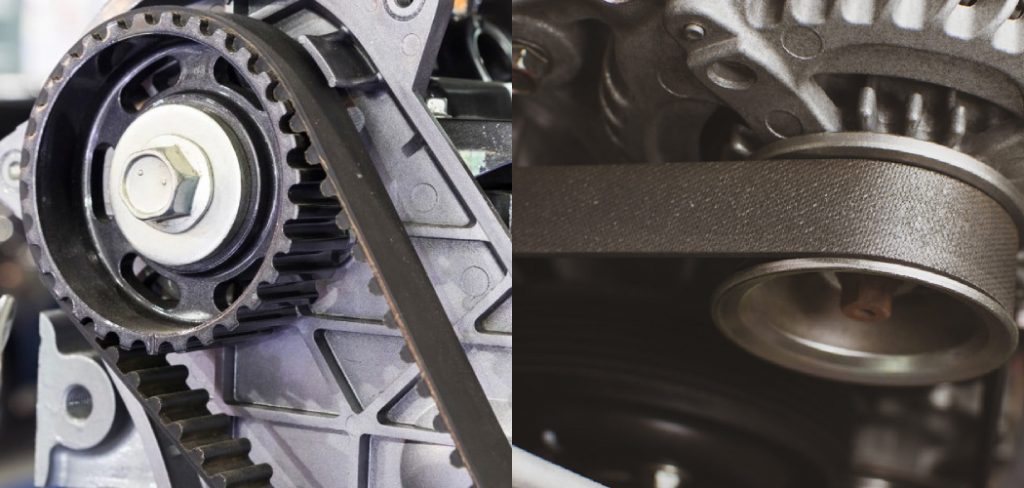
If you’re experiencing a timing belt noise, don’t worry – it’s a common issue and can be fixed! This blog post will outline how to fix timing belt noise. Keep reading to learn more!
Summary: If you’re experiencing belt noise, there are a few things you can do to try and fix the issue. First, inspect your timing belt to make sure it’s actually in good condition. If it’s not, you may need to replace it. Once you know that your timing belt is healthy, you can start to address the noise itself. There are a few things you can do to try and reduce the noise, such as changing the engine oil, replacing the air filter, and checking and tightening the belts. If those methods don’t work, you may need to replace the belt altogether.
What Causes Timing Belt Noise?
There are a few different things that can cause timing belt noise, including:
Worn-out Pulleys
The timing belt helps to keep the engine in time. It is connected to a series of pulleys that help keep it in place. Over time, these pulleys can become worn out, which can cause the timing belt to loosen and make noise.
Damaged Belt
If the timing belt is damaged, it can also cause noise. The damage can be caused by debris or oil getting on the belt, or by the belt coming into contact with a sharp object. The damage can also occur if the belt is installed incorrectly.
Incorrect Tension
The timing belt is a very important part of the engine. It needs to be just the right size, or it will make noise. If it is too loose or too tight, it can also cause noise. Incorrect tension can be caused by a variety of factors, including worn-out pulleys or an incorrect installation. Therefore, it’s important to ensure that the timing belt has the correct tension before starting the engine.
Worn-Out Bearings
The timing belt is connected to a series of bearings that help keep it in place. However, over time, these bearings can become worn out, which can cause the timing belt to make noise. Bearing noise is typically a high-pitched squeal. If you hear bearing noise coming from your car, it’s important to have it checked out by a mechanic as soon as possible. If the bearings are not replaced in a timely manner, they can cause the timing belt to fail, which can result in costly engine repairs.
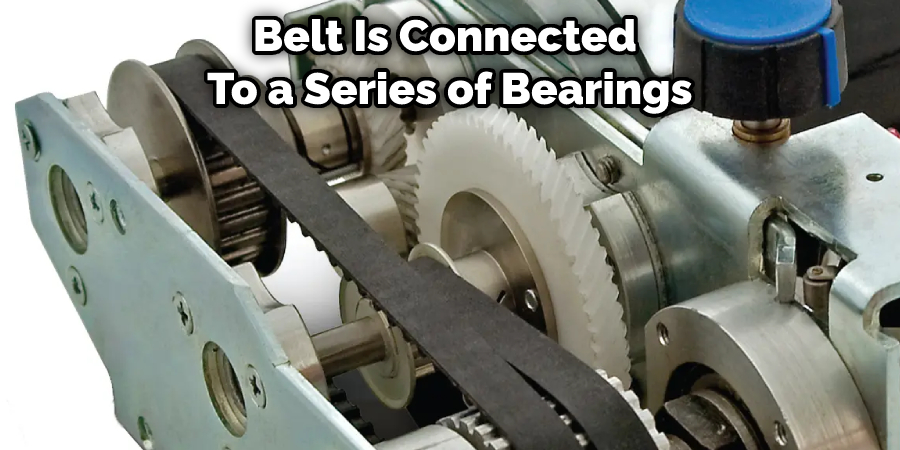
Worn-Out Engine Components
If any of the engine components that the timing belt is connected to are worn out, it can cause the timing belt to make noise. Engine components that cause noise include the timing chain, tensioner, or water pump.
How to Identify Timing Belt Noise
There are a few different ways that you can identify timing belt noise:
Listen for a Squealing Noise Coming From The Engine
If your car’s engine is making a squealing noise, it may be because the bearings are worn out. A loose or damaged belt can also cause this noise. Some engines are designed to make a squealing noise when they start up, but this is normal and not indicative of a problem.
Listen for a Ticking Noise Coming From The Engine
This is typically an indication that the chain or gears are worn out. A loose or damaged belt can also cause a ticking noise. If you hear a ticking noise coming from your engine, it is important to have it checked out as soon as possible. This is typically an indication that the chain or gears are worn out and, if left unaddressed, can cause further damage to the engine. A loose or damaged belt can also cause a ticking noise.
Look for Oil or Debris on the Belt
If you see oil or debris on the belt, it is an indication that the belt is damaged. This can be caused by a variety of things, such as an oil leak or debris getting caught in the belt. If you see oil or debris on the belt, it is important to have it checked the timing belt as soon as possible.
Step by Step How to Fix Timing Belt Noise
1. Identify the Source of the Noise
The first step is to identify the source of the noise. There are several ways to do this, but the most effective way is to use a stethoscope. First, locate the timing belt cover and remove it. Once you have access to the timing belt, put the stethoscope on the belt and have someone turn the engine over. If the noise comes from the timing belt, you can hear it clearly through the stethoscope.
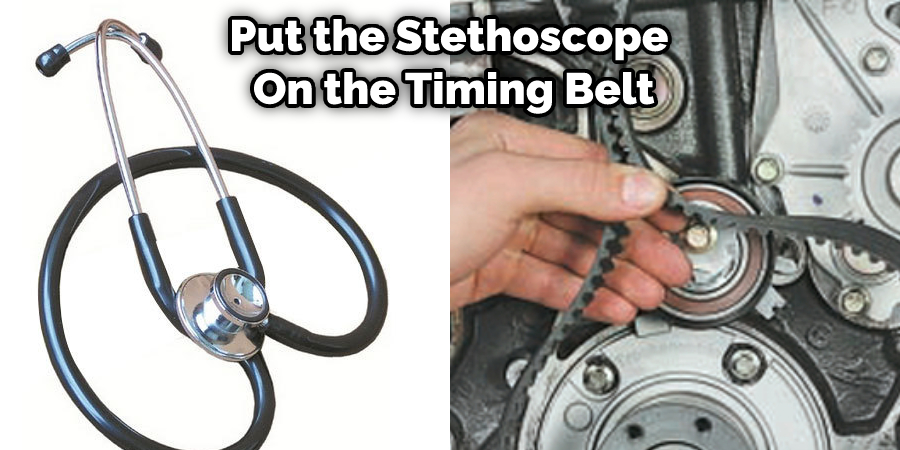
2. Check the Tensioner
The next step is to check the tensioner. The tensioner is responsible for keeping the timing belt tight; if it is loose, it can cause the belt to make a noise. To check the tensioner, remove the tensioner pulley and see if it is loose. If it is, you will need to replace it.
3. Check the Belt for Wear
If the tensioner is fine, the next step is to check the belt for wear. To do this, inspect the belt for any wear or damage. Next, check the pulleys for any signs of wear or damage. If you find any, you must replace the belt and pulleys. Use a micrometer to measure the belt’s thickness. It needs to be replaced if it is more than 0.12 inches thick.
4. Clean the Belt and Pulleys
If the belt and pulleys are in good condition, the next step is to clean them. First, remove the belt from the engine. Then, use a brush to remove any dirt or debris clinging to the belt or pulleys. Once the belt and pulleys are clean, re-install the belt and see if the noise has gone away.
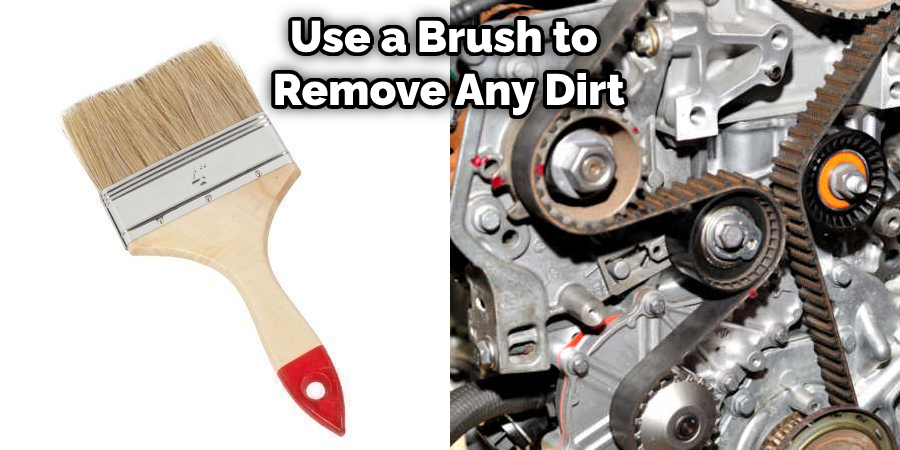
5. Adjust the Tensioner
If the noise has not gone away, the next step is to adjust the tensioner. To do this, first, locate the tensioner adjustment bolt. This is usually located on the side of the engine, near the timing belt. Next, use a wrench to turn the tensioner adjustment bolt clockwise. This will tighten the timing belt and hopefully eliminate the noise. If the noise persists, try loosening the tensioner adjustment bolt slightly. This will give the timing belt a bit more slack and may stop the noise.
You Can Also Check It Out to Fix Backed Up Septic Tank
6. Replace the Belt
If adjusting the tensioner does not stop the noise, replacing the timing belt is next. To do this, first, remove the old timing belt from the engine. Next, measure the old belt to find the correct size for the new one. Once you have the new belt, install it on the engine, starting with the crankshaft pulley. Work your way around the other pulleys, ensuring the belt is tight. Finally, adjust the tensioner again and start the engine to see if the noise is gone.
7. Lubricate the Belt
If the noise persists, the next step is to lubricate the timing belt. To do this, first, remove the belt from the engine. Then, apply a light layer of engine oil to the belt using a clean cloth. Be sure to avoid getting oil on the pulleys or other engine parts. Once the belt is lubricated, reinstall and see if the noise has diminished. If not, there may be an issue with one of the pulleys.
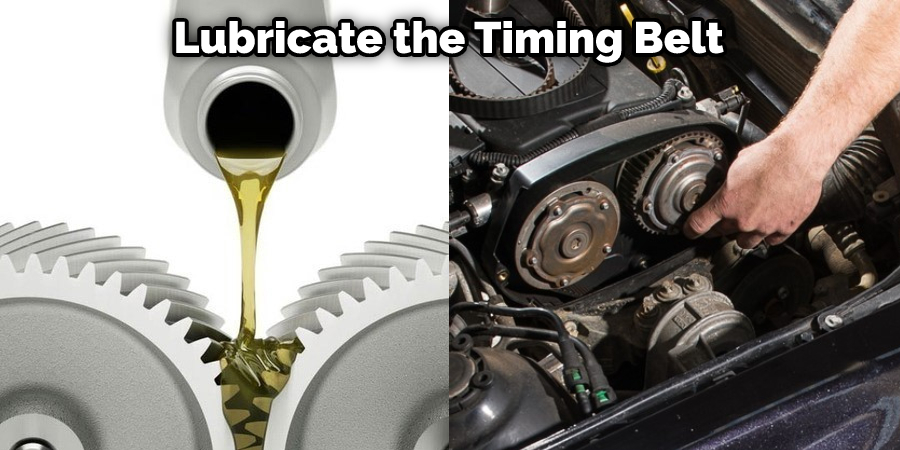
8. Replace the Pulleys
If lubricating the belt does not stop the noise, you may need to replace one or more of the pulleys. To do this, first, remove the old pulleys and then install the new ones. Make sure to use your car’s proper size and type of pulley. Remember to lubricate the new pulleys before installing them.
9. Inspect the Bearings
If the noise persists, the next step is to inspect the bearings. The timing belt runs over a series of bearings, and if one of these bearings is damaged, it can cause noise. To inspect the bearings, first, remove the timing belt covers. Then, spin the pulleys and listen for any noise. If you hear a grinding noise, the bearings are likely damaged and need to be replaced. It’s also a good idea to check the other bearings while you’re at it.
10. Check for Other Damage
If you’ve checked all of the above and the noise persists, there may be other damage to the engine. This could include damaged bearings or gears. In some cases, the timing belt itself may be damaged. If you suspect there is additional damage to the engine, it’s best to take it to a mechanic for further diagnosis.
Tips and Warnings on How to Fix Timing Belt Noise
Tips:
- Check your car’s owner’s manual to see when the manufacturer recommends replacing the timing belt.
- If you have an aftermarket timing belt, noise may be due to a poor installation. Check to ensure all the pulleys are lined up correctly, and the tensioner is in the correct position.
- Inspect the timing belt for cracks or fraying. If the belt is damaged, it will need to be replaced.
- Make sure all the pulleys and tensioners are properly lubricated. A dry belt can cause noise.
- If the problem persists, have your car checked by a mechanic.
Warnings:
- Do not drive your car if the timing belt is damaged. The engine could suffer severe damage if the belt snaps while the car is running.
- Be careful when working around the engine. Disconnecting and reconnecting the battery, for example, can cause electrical problems.
- Always wear gloves and safety glasses when working in your car.
- Never try to repair a timing belt unless you are experienced with auto repairs. Incorrectly installing a timing belt can cause serious engine damage.
Frequently Asked Questions
What Causes Noisy Timing Belt?
A noisy timing belt can be a sign of serious engine wear and may require replacement. The timing belt operates the valves, pistons, and other moving parts in your engine. Over time, it can become worn or damaged, which results in poor performance and noise. If you notice any unusual noises coming from your car’s engine, it is important to have it checked out by a mechanic as soon as possible.
In some cases, replacing the timing belt may be the best option for restoring smooth operation and reducing noise levels. Other modifications that might also be necessary include adjusting your spark plugs (if applicable), oiling your bearings regularly, checking water seals on crankcase cover & block halves every 10k miles or so (depending on driving conditions), and inspecting valvetrain components for wear/damage at least once per year (camshafts especially), etc…
It’s always important to maintain an up-to-date repair manual in case something goes wrong with your vehicle. This will allow you to make quick repairs without having to take it into a garage or dealership.
What Type of Noise Does the Timing Belt Make?
The timing belt makes a “clicking” or “thudding” noise when it’s in place and running. This noise is usually heard when the car is started – it’s like hitting two buckets together. The belt should not make this noise if it’s slipping, since that would mean the belt is too loose.
Will a Broken Timing Belt Destroy My Engine?
However, if you have any doubts or worries about the safety of your engine, it is best to have it checked out by a mechanic. A broken timing belt can cause serious damage to your engine, and may even require replacement.
Conclusion
So there you have it, a few tips on how to fix timing belt noise. If you follow these tips, you should be able to get rid of the noise and keep your car running smoothly. Thanks for reading, and feel free to share this article if you found it helpful.
You Can Check It Out to Fix Sewing Machine
